Yesterday, I posted my take on David Chang’s method for cooking eggs. While you can just eat the eggs with a drizzle of olive oil and a pinch of salt, they are really made to be served with something. Specifically, Chang usually serves them with bowls of ramen.
In my mind, real ramen noodle bowls are very intimidating. I’ve had great versions of them in various restaurants in New York, but I’ve never been to Japan.
I think the dish can be intimidating because while it looks like a very simple dish, the flavors can be deep and complex and when you start researching how to make the noodles and broth you enter a world that is just plain nuts.
People spend years learning how to make the perfect ramen broth and some broths take literally days of simmering, condensing, seasoning, and so forth.
For me, I’m happy to accept that I will probably never make a truly perfect bowl of ramen, but I think I can make a very good bowl of ramen. I can also make it in a few hours and I’m happy with that trade-off.
So, I’m showing you this – my Dashi Ramen – which takes just a few hours to make and is definitely worth those hours.
Dashi Ramen
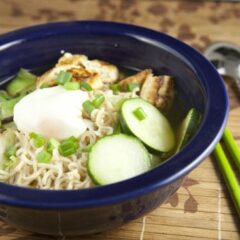
Ingredients
Broth:
- 3 large pieces kombu
- 1 oz shiitake dried mushrooms
- 4 cloves garlic, crushed
- 3 in ginger, chopped
- 10 c. water
- 3-4 dried bird chilis, opt.
- ⅔ c. dried bonito flakes
- 3 tbsp soy sauce
- 3 tbsp rice wine vinegar
Quick Pickles:
- 1 large cucumber, sliced thin
- ⅓ c. rice wine vinegar
- 1 tsp sugar
- 1 tsp kosher salt
- Pinch of red pepper flakes
Other Ingredients:
- Ramen Noodles, 4-5 ounces/bowl
- Seared Tofu, 3 ounces/bowl
- Seared baby bok choy, 1/2 head/bowl
- 1 poached egg/bowl
- Chopped scallions
Instructions
- For broth, bring water to just under a simmer. Add kombu, mushrooms, garlic, ginger, and chilis. Let steep for about 20-30 minutes.
- Remove kombu, add bonito flakes and cook for 3-4 minutes. Then strain broth.
- Bring strained broth to a simmer and simmer until the broth is reduced to about half it’s original volume. Season with soy sauce and vinegar. It will take around an hour for the broth to reduce.
- For the quick pickles, just slice cucumbers thin and stir in a bowl with other ingredients. Make sure they are coated evenly and let them sit for at least an hour. Drain and serve with ramen.
- Sear tofu in a large skillet over medium-high heat with a drizzle of oil for about 5 minutes per side until it’s nicely seared. Also sear bok choy in the same skillet. Cut the baby bok choy in half, drizzle with oil and sear cut side down for five minutes over high heat.
- Cook ramen according to package right before sering.
- Immediately serve hot noodles with chopped seared tofu, bok choy, pickles, a poached egg (see previous post), and chopped scallions.
- Ladle simmering broth over the whole bowl and eat immediately. Feel free to season with extra soy sauce or any other sauce.
- You can store the broth in the fridge for up to a week or freeze it for months.
Nutrition
Did you make this recipe?
Dashi Ramen
The Broth
There are those people who think ramen is about the noodles and then there are those that think it is about the broth.
Ok. There’s actually a third group who think you have to have both perfect, but for me, the broth is more important than the noodles. I did my best to make a good broth for my Dashi Ramen that can be made in a few hours but still has lots of flavor.
There are two ingredients which may be new to some people for this recipe. Both can be found at almost any Asian food store in America.
The first is Kombu, which is just large strips of kelp. Many Dashi Ramen broths start with this as a base layer. It just gives a lot of savory flavor to the broth, but is pretty light.
The second ingredient is bonito flakes which are basically dried fish flakes that have been smoked. This ingredient is strong and when you open the bag, you’ll be treated to a wonderfully smokey smell. They almost dissolve in the broth and give it all kinds of flavor.
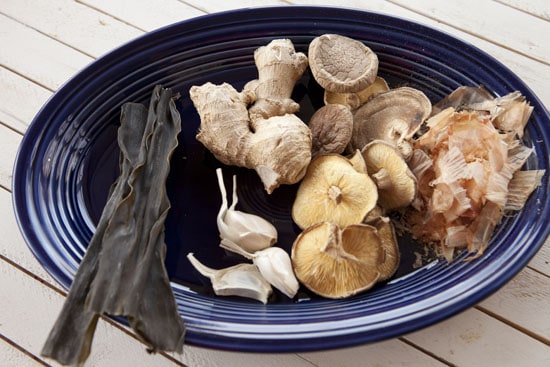
When you are making the broth, you don’t want your water to be boiling. It should be just below a simmer point. Add the kombu, mushrooms, ginger, garlic, and chilis and let it steep for about 30 minutes.
This will smell wonderful. Promise.
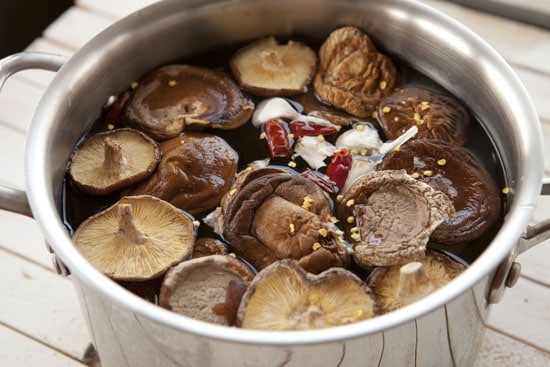
After thirty minutes or so, you can go ahead and remove the kombu. They will be huge after expanding in the water. They’ve contributed all they can to the broth at this point.
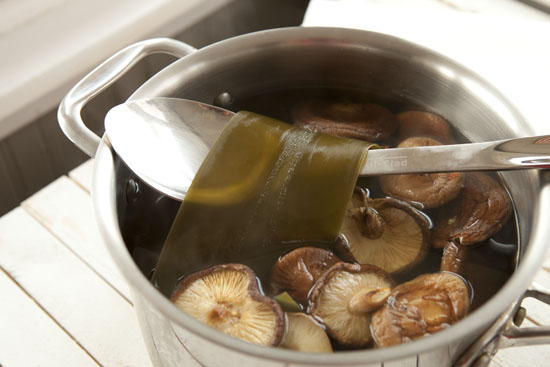
Then go ahead and add all those bonito flakes! They will seem to basically dissolve in the broth.
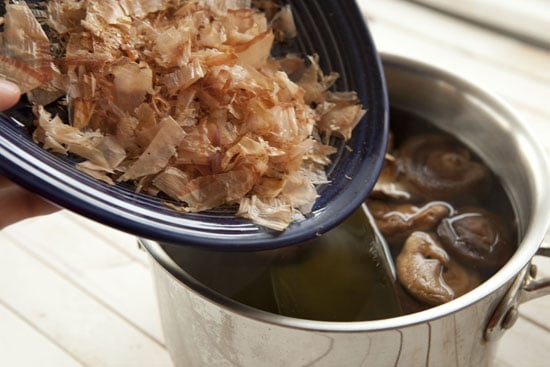
Once the flakes go in, you only need to simmer it for about four minutes. Then you can strain out all the stuff and you’ll be left with a really clear and light broth.
If you have one, use a wire mesh strainer to make sure you get all the bits. You can also strain the broth through cheesecloth.
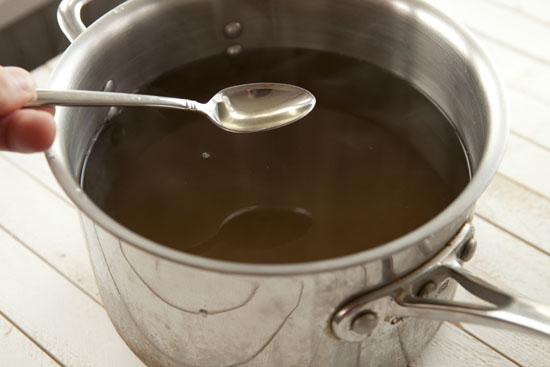
Now you can return the pot to the heat and bring the broth to a simmer. Let the broth simmer until it reduces by about half. As it reduces, the flavors will intensify and you’ll be left with a really flavorful broth.
Also, season the broth with soy sauce and rice wine vinegar as it reduces.
The reduction process will take at least an hour. Meanwhile, you can work on your other parts!
The Pickles
Any sort of pickled vegetables go great in ramen bowls. Pickled peppers would work also.
For this version, I made some super fast sliced pickles with rice wine vinegar, sugar, salt, and some red pepper flakes. Just slice the cucumbers thin and stir everything together. Let these sit for at least an hour and you’ll have some really light pickles to serve with the ramen.
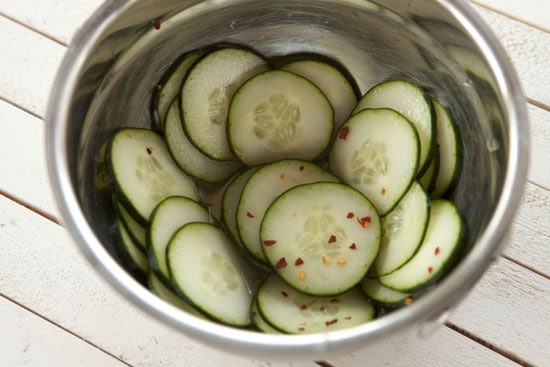
Noodles Noodles
Good ramen noodles are tough to find in the US. I would say to just do your best. Of course, you could try to make them, but I wanted to focus on the broth for this attempt so I just went with some store-bought noodles.
I just used some basic Japanese style noodles for my version. Nothing fancy.
For me, I think one package (3.5 ounces) isn’t enough for a dinner-sized portion so I usually will cook three packages for two people.
The only note about the noodles is that I recommend cooking them in just water and not in the broth that you are making. If you cook them in the broth, it will make it too thick so just cook it in water separately.
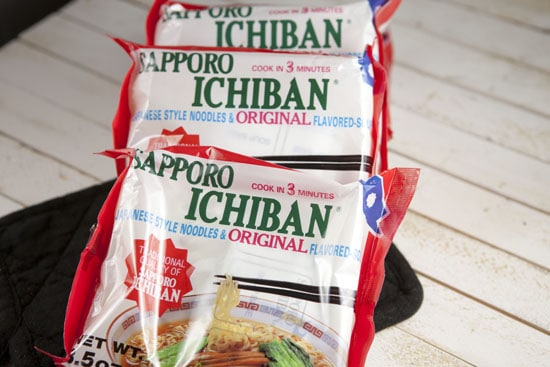
Other Extras
Ramen is frequently served with some sort of roasted meat like pork or chicken or beef, but I wanted to keep this version light so I served mine with seared tofu and bok choy.
I just heated a small skillet over medium-high heat and added a drizzle of oil. When it was hot I cooked some baby bok choy, cut-side down in the skillet for about four minutes until it was nicely seared. This left the bok choy a bit crunchy, but still cooked.
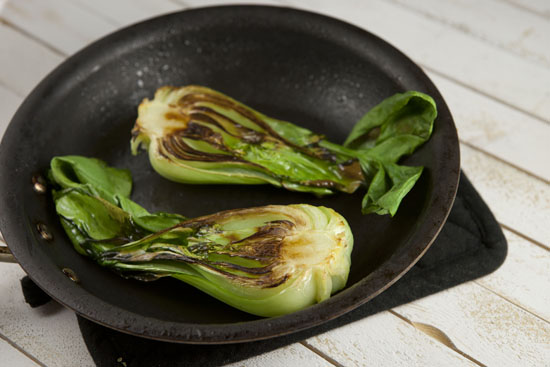
I also lightly pressed some extra firm tofu and then seared it off in the same pan for about four minutes per side.
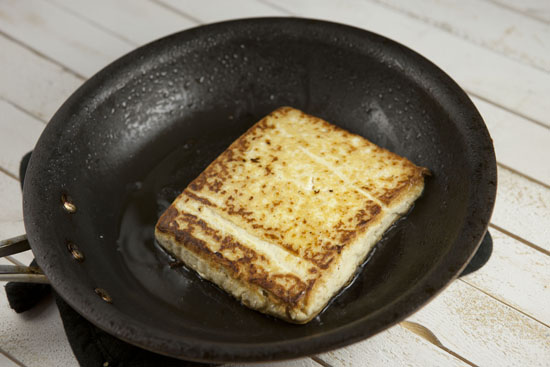
Serving the Ramen
When you’re ready to eat, cook your noodles last so they are nice and hot. Add them to the bowl and surround them with your fixings. I like to put a poached egg right in the center.
Then ladle simmering hot broth over the whole thing and garnish it with chives or scallions.
Of course, people can season with extra soy sauce or chili sauce if they want.
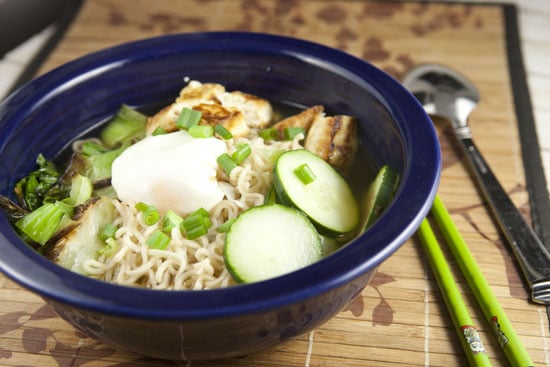
This was a little work, but far from the amount of work that goes into some ramen bowls. It had plenty of flavor in my opinion though and was a great warming dinner on a cold winter night.

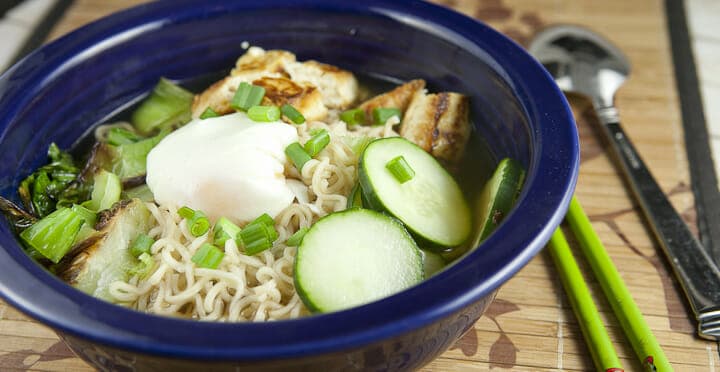
corinne
Have you ever seen Tampopo? Japanese movie in part about the difficulties of creating the perfect bowl of ramen. But way less stupid than that sounds…
Nick
Added to my list! Sounds really cool. Thanks for the rec. :)
Flora
For you, this is a simplified recipe, but for me it’s a step up in complexity from my recent staple of Sapporo Ichiban dolled up with red cabbage, sesame oil, and hot pepper flakes.
This dashi looks good. The recipes I’ve tried before may (or may not) have been authentic, but their flavor was so mild that if I didn’t use filtered water I could hardly taste the seasonings over the chlorine. I’ll be trying this soon.
Those fresh pickles are a summer staple for me, although I use less vinegar.
Nick
Hey Flora, the broth is lighter than say a chicken or beef stock, but I thought it had plenty of flavor. I didn’t use filtered water for my version and thought it was just fine. Thanks for the comment!
Phil
You also live in Colorado, home (speaking generally) of the tastiest tap water in the USA, so that’s going to skew things ;-)
Bill
Is there any advantage or disadvantage to poaching the egg (without plastic bag) in the dashi directly?
Peggy
Making dashi was my favorite part of Japanese cuisine at school. It’s such a humble but versatile broth. Well done, Nick!
Meg @ www.ourwaytoeat.com
I wonder what a vegetarian would sub for Bonito flakes to achieve an equally flavourful result. Just skip ’em?
Nick
Probably yea… I don’t know of a substitute. I would up the mushrooms though for sure to keep the savory flavors going…
Maas
this was fucking disgusting, I ordered pizza after I threw everything away.
lindywise
You are an idiot. Stick with Mcdonalds and stop abusing the real cook. Love your article on Lasagna, dude, thanks.
Lea
Hi,
Thank you for sharong the recipe. But I must say it did taste really bad..It wasn‘t like delicious Ramen at all. I did everything as said. The vinegar made it acidic and sour and the Bonitas were too much, I would add just a little bit ( even less than 1/3 cup).
Roboto
This looks as good as what I’ve had in Japan. The bonito flakes are a nice touch of Japanese authenticity.
Foogod
I just came across this.. A couple of tips for folks who are not used to working with some of these ingredients:
Always measure bonito flakes by weight, not by volume. They can come with different thickness of shavings and they’re also generally so light/fluffy that it’s really impossible to tell how much “1/3 cup” is giving you. Likewise, there are many different things that people sell as “konbu”, in different forms, so this should also be measured by weight, not “pieces”. My general rule of thumb for basic dashi is 10g of konbu and 10g of bonito for every liter of water (but for strongly-flavored broths like this, doubling that ratio would not be unreasonable).
DO NOT BOIL the konbu! This was mentioned here, but I think not strongly enough. If you let the dashi boil at any point with the konbu in it, it will end up with a much stronger “seaweedy” flavor that is not generally a good thing.
Rice vinegar can also vary dramatically in quality. Some (I recommend Marukan) can be remarkably complex with mellow acidity and others (to my taste) are almost like paint thinner, so it’s worth shopping around. Also be careful of the difference between regular rice vinegar and “seasoned” rice vinegar (which typically has a lot of sugar and other things added to it). Note that you will also get less acidity if you add the vinegar earlier in the boil than if you add it at the end, as acetic acid does naturally evaporate off during boiling.
Shari Steiner
How fantastically helpful! Your comments make the whole recipe so much more enjoyable – and more do-able. Thanks!
pge outage map
Making authentic ramen noodle bowls can indeed seem intimidating, especially when you consider the complexity of the flavors and the traditional methods of preparing the noodles and broth.
timothyferriss
This recipe offers a simplified approach to making ramen at home, and while it may not be as time-intensive as some traditional ramen recipes, it still delivers plenty of flavor and warmth for a satisfying meal retro bowl